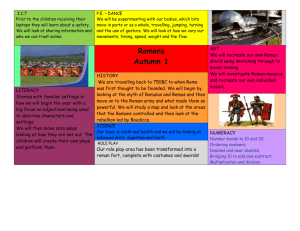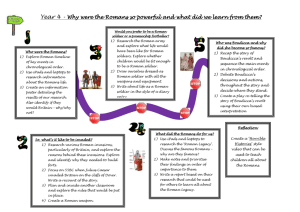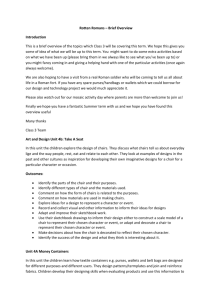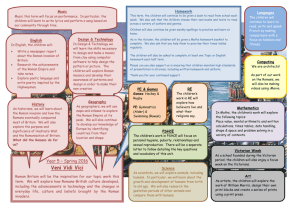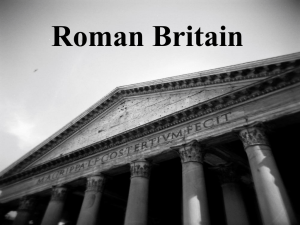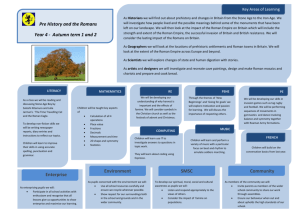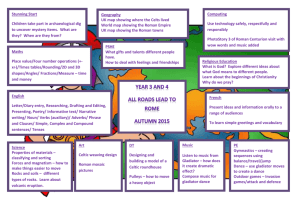YEAR 3/4 - schoolslinks.co.uk
advertisement
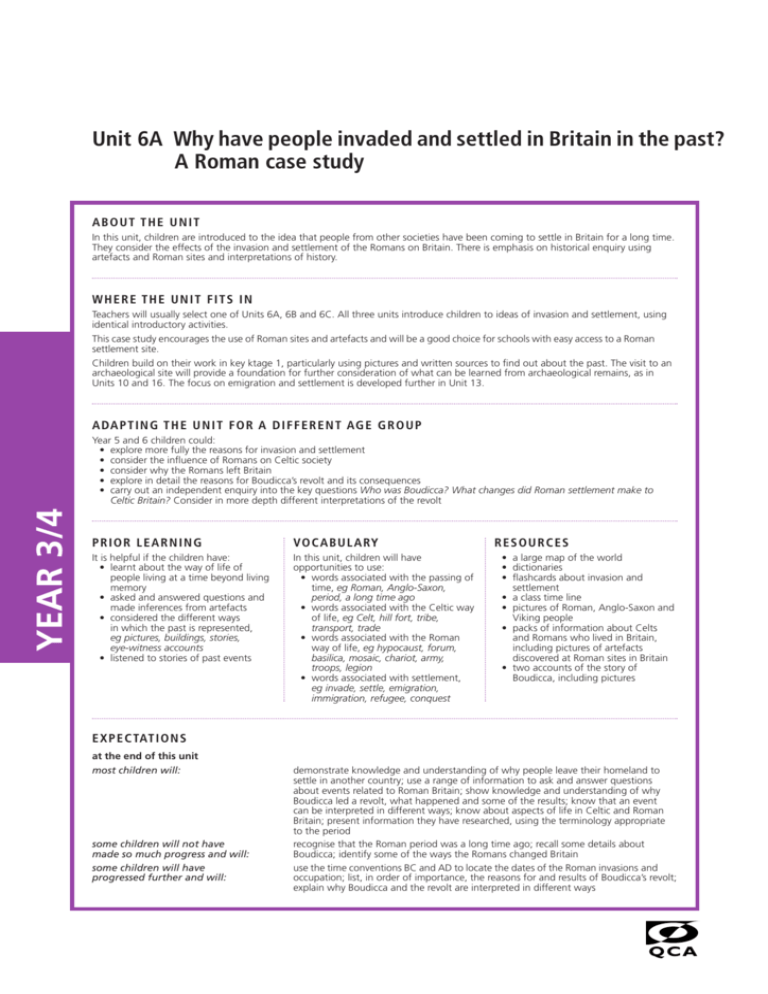
Unit 6A Why have people invaded and settled in Britain in the past? A Roman case study ABOUT THE UNIT In this unit, children are introduced to the idea that people from other societies have been coming to settle in Britain for a long time. They consider the effects of the invasion and settlement of the Romans on Britain. There is emphasis on historical enquiry using artefacts and Roman sites and interpretations of history. WHERE THE UNIT FITS IN Teachers will usually select one of Units 6A, 6B and 6C. All three units introduce children to ideas of invasion and settlement, using identical introductory activities. This case study encourages the use of Roman sites and artefacts and will be a good choice for schools with easy access to a Roman settlement site. Children build on their work in key ktage 1, particularly using pictures and written sources to find out about the past. The visit to an archaeological site will provide a foundation for further consideration of what can be learned from archaeological remains, as in Units 10 and 16. The focus on emigration and settlement is developed further in Unit 13. A DA P T I N G T H E U N I T F O R A D I F F E R E N T AG E G R O U P YEAR 3/4 Year 5 and 6 children could: • explore more fully the reasons for invasion and settlement • consider the influence of Romans on Celtic society • consider why the Romans left Britain • explore in detail the reasons for Boudicca’s revolt and its consequences • carry out an independent enquiry into the key questions Who was Boudicca? What changes did Roman settlement make to Celtic Britain? Consider in more depth different interpretations of the revolt PRIOR LEARNING VO C A BU L A RY It is helpful if the children have: • learnt about the way of life of people living at a time beyond living memory • asked and answered questions and made inferences from artefacts • considered the different ways in which the past is represented, eg pictures, buildings, stories, eye-witness accounts • listened to stories of past events In this unit, children will have opportunities to use: • words associated with the passing of time, eg Roman, Anglo-Saxon, period, a long time ago • words associated with the Celtic way of life, eg Celt, hill fort, tribe, transport, trade • words associated with the Roman way of life, eg hypocaust, forum, basilica, mosaic, chariot, army, troops, legion • words associated with settlement, eg invade, settle, emigration, immigration, refugee, conquest RESOURCES • a large map of the world • dictionaries • flashcards about invasion and settlement • a class time line • pictures of Roman, Anglo-Saxon and Viking people • packs of information about Celts and Romans who lived in Britain, including pictures of artefacts discovered at Roman sites in Britain • two accounts of the story of Boudicca, including pictures E X P E C TAT I O N S at the end of this unit most children will: some children will not have made so much progress and will: some children will have progressed further and will: demonstrate knowledge and understanding of why people leave their homeland to settle in another country; use a range of information to ask and answer questions about events related to Roman Britain; show knowledge and understanding of why Boudicca led a revolt, what happened and some of the results; know that an event can be interpreted in different ways; know about aspects of life in Celtic and Roman Britain; present information they have researched, using the terminology appropriate to the period recognise that the Roman period was a long time ago; recall some details about Boudicca; identify some of the ways the Romans changed Britain use the time conventions BC and AD to locate the dates of the Roman invasions and occupation; list, in order of importance, the reasons for and results of Boudicca’s revolt; explain why Boudicca and the revolt are interpreted in different ways Unit 6A Why have people invaded and settled in Britain in the past? A Roman case study LEARNING OBJECTIVES P O S S I B L E T E AC H I N G AC T I V I T I E S CHILDREN SHOULD LEARN • to relate their own experience to the concept of settlement • to recognise that people have been moving between different areas for a long time, and that some reasons for moving were the same as those of people alive today LEARNING OUTCOMES P O I N T S TO N OT E CHILDREN Why do people move away from where they were born? Discuss the children’s and their families’ experiences of moving home to live either in a different part of the country or in a different country. Use a map to establish where they moved to and from. Encourage the children to suggest why they or their families moved, and list the reasons given. Help them to sort the reasons into those where families chose to move and where they had to move. • give reasons why families leave the place where they were born • recognise that some people choose to leave and that others have to leave the place where they were born This discussion needs to be handled with sensitivity and care, especially if there are any refugee children in the class. It is important to draw out that some reasons for moving today are similar to why people moved in the past, eg for work, to make a new life, because of fear. Recognising that communities are made up of people from different places, backgrounds and cultures can lead into a discussion of the workings of local and national communities, as a link to citizenship education. Take opportunities to use and explain words like settlement, emigration, immigration, refugee, and how these are different from words like invasion, conquest. If there are few children in the class whose families have moved from another country it will be necessary to refer to groups of immigrants that the children know about. • to use the terms ‘invade’ and ‘settle’ • to place the Celtic and Roman periods in a chronological framework • to recognise characteristics that place Celts and Romans as having lived a long time ago in the past • that Romans invaded Britain and that the period of conquest was followed by a period of settlement Who invaded and settled in Britain a long time ago? Ask the children to find the dictionary definitions of the words ‘invade’ and ‘settle’. Ask them to write their definitions in a two-column grid. Lead a discussion to develop the children’s understanding of these terms. Give the children cards with words and phrases that could be connected to either invasion or settlement, eg stay, arrive, conquer, land, visit, remain. Ask the children to place the cards in the correct columns on their grids. Ask them to feed back where they placed each word and why. Establish that groups of people have been visiting, invading and settling in Britain for a very long time. Ask the children to look at the class time line and pick out the people and events they have already learnt about, eg the Great Fire, Florence Nightingale. Discuss with the children whether these people or events happened a long time ago, and which occurred the longest time ago. • use a dictionary to find the meanings of ‘invade’ and ‘settle’ • sort words or phrases correctly under the headings ‘invade’ and ‘settle’ • locate on a time line historical events that they have already studied • select distinctive characteristics of Celtic and Roman people • sort pictures to show understanding of features of Celtic and Roman life • discuss ideas associated with invasion and settlement The class time line will need to include Celtic, Roman and Anglo-Saxon periods. • select relevant information from a number of sources • complete a grid with relevant information using correct terminology for Celtic and Roman ways of life • suggest similarities and differences between the lifestyles of Celts and Romans It is important that the Celts are not presented as a set of primitive tribes. They were sophisticated, but different from the Romans. The issue could be highlighted by comparing the impression created by Julius Caeser’s comments about the Celts from his story of his visits in 55 and 54 BC with the impression given by examples of Celtic artwork. This activity would provide a useful context for reinforcing dictionary skills. The class might consider the range of definitions in dictionaries and information books, as a prelude to children developing their own definitions of the terms. The activity could be adapted by giving children a grid with the dictionary definitions already in place. Give the children pictures of a Roman and Celtic person. Encourage them to suggest clues that indicate these people lived a long time ago. Help the children to place the pictures at the appropriate place on the time line. Give the children pictures showing a variety of Roman and Celtic images, eg in armour, in battle, town life, country life, home life. Ask the children to sort them first into Roman and Celtic groupings, and then into invasion and settlement groupings. Discuss with the children the relationship between invasion and settlement. • to select and record information about Celtic and Roman ways of life • to make comparisons between these lifestyles • about aspects of life in Celtic and Roman Britain, using a variety of resources Who were the Celts and who were the Romans? Ask the children to locate the Roman period on the class time line. Tell them that they are going to find out about the Romans and also about the Celts, who lived in Britain before the Romans arrived. Give them information about and pictures of the Celts and/or the Romans. Ask the children to complete a three-column grid with the headings: ‘How they did things’, ‘Celts’, and ‘Romans’. In the first column children can list aspects such as dress, belief, language, towns, farms, art, technology. They can use the other two columns to compare the two ways of life. Discuss the children’s answers with them, drawing their attention to similarities and differences. Children could develop this activity further by investigating the lifestyle of Celtic tribes, eg language, beliefs, dress, art, settlements such as hill forts, towns, farms and/or considering the Roman way of life, eg the importance of Latin, gods, dress, the organisation of the army, houses and their interior design. Children could be divided into groups for this activity, with some groups looking at Celts and others the Romans. This activity could be adapted by asking children either to make labelled drawings or write their answers in sentences, as appropriate. • that sources about Boudicca contradict each other • that there are different opinions about Boudicca Who was Boudicca? Show the children images of Boudicca. Ask them to describe what they see, drawing their attention to the differences in how she is portrayed. Discuss with the children what kind of person they think she was and why they think this. Ask the children to record their findings. Help them to find evidence that confirms or contradicts their ideas. Read two different descriptions of Boudicca. Ask the children to identify similarities and differences between the stories. Ask the children to draw a picture of Boudicca and write a short description of what they think she was really like. 1 • select information from pictures, which supports or contradicts other information • identify similarities and differences between two written descriptions of Boudicca • produce a description of Boudicca that draws on more than one source of information Possible sources of information on Boudicca are: text books, postcards, contemporaneous writers, eg Tacitus, Dio Classius, pictures of modern interpretations, eg statues outside the Houses of Parliament or in Cardiff city hall, pictures on book covers. Children could record their findings in a two-column grid with the headings: ‘What we know’, and ‘Source of information’, with prompts such as hair, height, character, temper, colouring. This activity could be adapted by asking the children to make a labelled drawing of Boudicca instead of a written description. 2 Continued overleaf LEARNING OBJECTIVES P O S S I B L E T E AC H I N G AC T I V I T I E S CHILDREN SHOULD LEARN • the main events in Boudicca’s revolt • the reason for the revolt • that there are different interpretations of the revolt LEARNING OUTCOMES P O I N T S TO N OT E CHILDREN What happened in AD 60? Tell, read, or ask the children to read, the story of Boudicca’s revolt. Ask them to retell the story in storyboards. Ask the children to read a different version of the story, eg a play, and look for similarities and differences between the two stories. Ask children to compare the two interpretations of the story by answering targeted questions. • sequence the main events of the revolt on a storyboard • consider questions to identify similarities and differences between two versions of the event • suggest one or more reasons for the revolt This activity could be extended by asking children to consider why, when the Romans were so successful against Boudicca, they were less successful against other Celtic leaders and eventually needed to build Hadrian’s Wall to separate Romanised and unconquered tribes. Examples of a completed worksheet for this type of activity can be found in Expectations in history (SCAA, 1997, page 13). Discuss with the children the causes of the revolt and, with their help, arrange the causes in order of importance. • about the results of Boudicca’s revolt • to appreciate that people have points of view about events in the past What were the short-term and long-term results of Boudicca’s revolt? Discuss with the children the immediate consequences of the revolt for the Celts and the Romans and record these on a big piece of paper. Also discuss the longer-term impact of the revolt on Britain. Comparison of different texts about Boudicca would allow the class to reinforce and extend their understanding of the differences between fiction and non-fiction text, eg to distinguish between fact and opinion. Books with a particularly strong point of view would provide a useful context to explore how an argument is constructed and presented. • suggest consequences of Boudicca’s revolt • select information to show how a Roman or a Celt would have perceived the revolt It is important to emphasise that the population of Britain did not become Romans, but that the Celts adopted Roman lifestyles. Many Celts living far away from the towns retained their old lifestyles throughout the Roman period. • select information about life in Roman Britain from a range of sources • present information to show understanding of the impact of Roman settlement on Britain It may be helpful to discuss with the children what happens to buildings when they are not used – that they might be demolished, or become decayed and eventually buried. Encourage them to think about which materials survive over long periods and which decay, and to suggest why more Roman buildings survive than Celtic ones. Ask the children to think about how a Celtic or Roman survivor of the revolt might feel. Provide them with a suitable sentence-starter and ask them to write about the results of the revolt from the point of view of either a Celt or a Roman. Discuss with the children why people might view the revolt differently. • about evidence that tells us about life in Roman Britain • ask and answer questions about what survived from the Roman settlement of Britain How did the Romans change Britain when they settled here? Arrange a visit to a Roman site. Before the visit, tell the children that many Romans settled in Britain and introduced some of their customs and ways of life, eg towns, baths, new forms of religion and farming methods. Tell them that the Celts responded by building villas and adapting Roman styles of pottery and dress. Ask the children to suggest what they would like to find out about on their visit. Develop a list of questions for them to use at the site. Take the children to the site and look for evidence of Roman lifestyles. Help the children to answer the prepared questions. After the visit, ask the children to create a classroom display, or produce a child’s guide to the site they visited. These activities could be developed into a local study if there are Roman remains close to the school. Where a site visit is not possible, children could be asked to work from a variety of picture sources, texts and publications, for example those produced about a major Roman site. To help with this part of the activity children could be given pictures of Roman artefacts from the site they will visit. Ask them to annotate the pictures, using different colours to show what they know, can guess at, or would like to know about each object. Unit 6A Why have people invaded and settled in Britain in the past? A Roman case study 3 4 Ref: QCA/98/252 © Qualifications and Curriculum Authority (QCA) 1998
